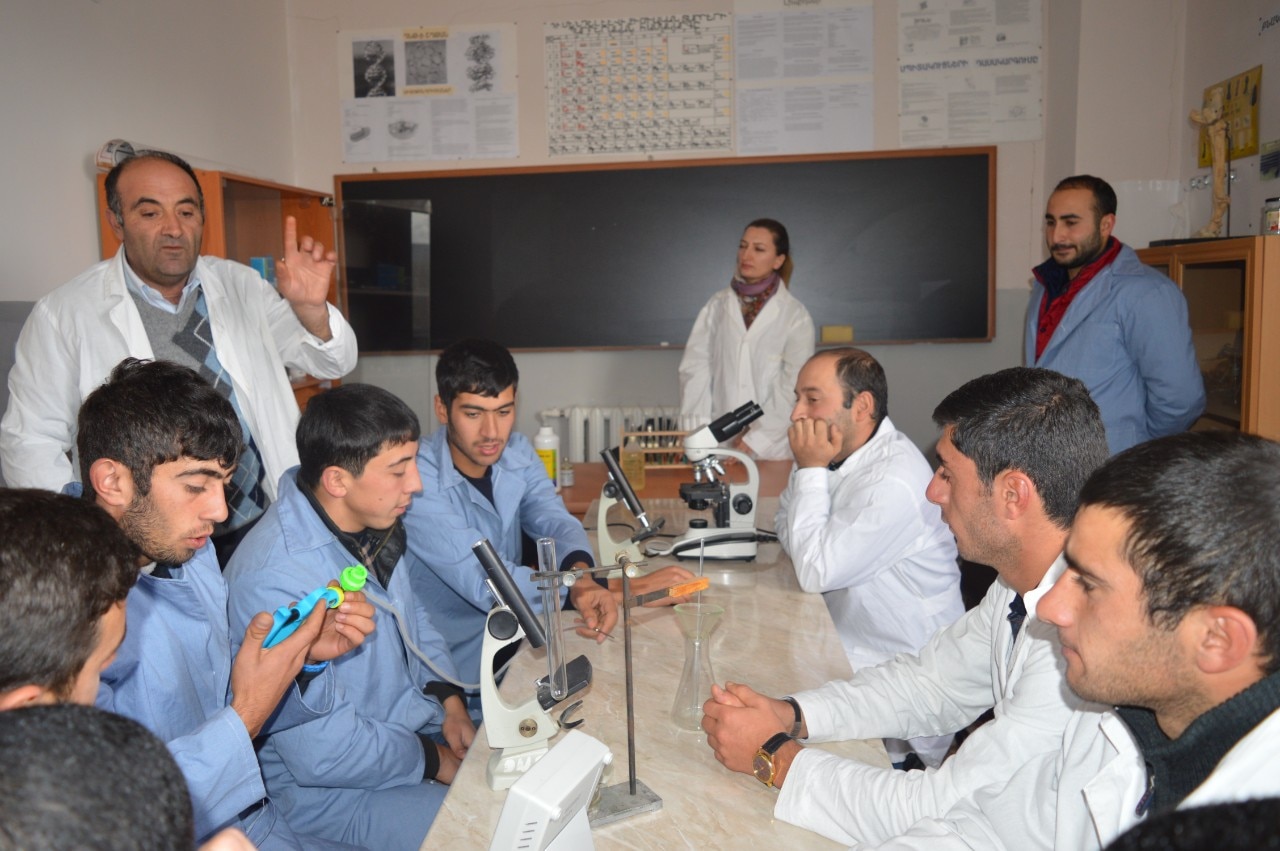Modernizing VET in Agriculture in Armenia
While 37% of Armenia’s labour force is employed in agriculture, men and women do not earn sufficient income, incl. due to a lack of professional skills. This multi-stakeholder intervention, which includes a SDC contribution, further develops country-wide work-based learning education, strengthens specialized institutions and modernizes the regulatory framework, enabling professionals and graduates to acquire relevant qualification, find employment or establish their own businesses.
| Country/region | Topic | Period | Budget |
|---|---|---|---|
|
Armenia |
Agriculture & food security Inclusive economic Development
Vocational training
Agricultural services & market Rural development |
01.12.2021
- 31.08.2025 |
CHF 7’710’000
|
 Young Armenian farmers receive Vocationa Education and Training in Agriculture
© Strategic Development Agency SDA / Swiss Cooperation Office South Caucasus SCO
Young Armenian farmers receive Vocationa Education and Training in Agriculture
© Strategic Development Agency SDA / Swiss Cooperation Office South Caucasus SCO
- Central State of South East
- Swiss Interchurch Aid
- National State Institute North
- Foreign private sector North
- Foreign private sector South/East
-
Sector according to the OECD Developement Assistance Commitiee categorisation EDUCATION
AGRICULTURE
OTHER MULTISECTOR
Sub-Sector according to the OECD Developement Assistance Commitiee categorisation Vocational training
Agricultural services
Rural development
Cross-cutting topics The project also supports partner organisation improvements
Aid Type Mandate without fiduciary fund
Project and programme contribution
Technical assistance inclusive experts
Project number 7F10375
| Background | Overall, the project aims at (I) improving knowledge and skills to contribute to sustainable, climate friendly, inclusive growth, (II) increasing incomes and (III) enhancing (self)-employment of male and female professionals and graduates in agricultural and related fields. |
| Objectives |
Since 2016, HEKS/EPER and the local partner SDA have been working on A-VET, and GIZ launching important policy and capacity development processes at a macro level. Particularly, • Dual VET in wine, tourism, IT, transport and logistic sectors with nine short-term dual VET courses at nine VET colleges have been piloted. • The curricula for Veterinary and Milk & Dairy Technology professions have been revised according to the Work Based Learning (WBL) educational model, approved and piloted at two colleges. • 2019-2023 Strategy for Preliminary (Craftsmanship) and Middle Vocational Education and its Action Plan has been developed. • Efforts have been made towards regulatory reforms and institutional setup of qualifications, human capacity development measures, private sector engagement etc. Although important progress have been made, the two projects were not in a position in their first phases to fully establish new structures, standards and institutions of a work-based vocational education in a sustainable manner: conceptual work needs to be expanded and deepened, reform processes completed, the know-how accumulated in the hands of international stakeholders to be transferred to state institutions. |
| Target groups |
Living Landscapes for Market Development in Armenia (LILA), • Sustainable and Inclusive Growth in Mountainous Armenia (SIGMA), • Activities by the Government of the Republic of Armenia and relevant ministries • Experience sharing with other regional and local projects in South Caucasus (e.g. WEE, VET in GE) • Collaborating with likeminded donors |
| Medium-term outcomes |
1.1 VET-courses and curricula are offered innovatively and in-line with the needs of the rural population and the private sector. 1.2 VET colleges are strengthened, and teachers capacitated. 1.3 Private sector actors collaborate within the local knowledge system. 1.4 Women and vulnerable groups are incentivized to undergo developed A-VET courses. 2.1 Laws and governmental regulations for anchoring and sustainable development of dual VET are revised. 2.2 Cooperation structure(s)/mechanism(s) with all relevant parties established and operational, in particular in A-VET 2.3 Managerial capacities of public and private actors on professional association levels are improved, in particular in A-VET |
| Results |
Expected results: Target groups are • young male and female professionals and graduates interested in farming and related professions; • farms as small, medium and large enterprises interested in farming and related professions; • institutions offering A-VET courses and related regulatory authorities; being capacitated and empowered by a modernized A-VET system. Results from previous phases: Outcome 1: Professionals and graduates are enabled by the A-VET system a) to apply agricultural and related knowledge, skills and attitudes which are in demand by the market, b) to find or create sustainably decent income generation opportunities, and c) to contribute to innovative approaches, solutions, products and services in the market. Outcome 2: The dual VET system is effective (in particular the A-VET system), based on coherent policies, capacitated institutions, and an established cooperation between the public and the private sector. |
| Directorate/federal office responsible |
SDC |
| Project partners |
Contract partner Private sector Foreign state institution Swiss Non-profit Organisation |
| Coordination with other projects and actors |
Delegated Cooperation Agreement SDC - Austrian Development Agency (ADA) (ADA delegates to SDC) Contributions contracts with Swiss Church Aid (HEKS/EPER) for Outcome 1 and German Corporation for International Cooperation (GIZ) for Outcome 2 |
| Budget | Current phase Swiss budget CHF 7’710’000 Swiss disbursement to date CHF 4’819’505 |
| Project phases | Phase 1 01.12.2021 - 31.08.2025 (Current phase) |
